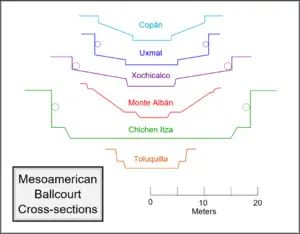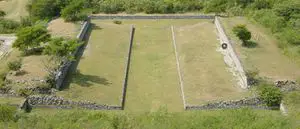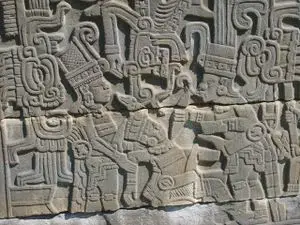What Was the Purpose of the Mesoamerican Ballgame
To the many cultures of Mesoamerica – which includes the Olmecs, Maya, Toltecs, Aztecs, and others – a sport known today as “the ballgame” played an important role in their daily lives. From el Salvador to the American southwest, remnants of ball courts where different versions of the ballgame were played are a visual testament to the ubiquitous nature of the ballgame in Pre-Columbian North America. For more than 2,000 years the ballgame was played and there are a plethora of primary sources that relate many of its details, which include the following: extant stone ball courts in Mexico, Mesoamerican artistic depictions of the game, and Spanish accounts.
There is little doubt that the ballgame was popular in Pre-Columbian Mesoamerica, but what was its purpose? An examination of the primary sources together with archaeological studies of Mesoamerican sites reveals that the ballgame actually served many purposes. The primary purpose of the ballgame appears to have been theological, as the game represented different religious aspects important to the people of Mesoamerica, including the cycles of the sun, fertility, and maize. Although religion may have provided the basis for the ballgame, the game also served to facilitate social and political processes, such as ceremonial feasting, a venue for treaties, and a substitute for war. Finally, like all sporting events throughout history, the ballgame was also a source of entertainment, where spectators bet on games and watched with trepidation because sometimes the losers were sacrificed to the gods.
The Historical Background of the Ballgame
The first version of the ballgame was part played more than 3,000 years ago in the region around what is today Veracruz, Mexico by a people known as the Olmecs. The term Olmec is actually a later, Nahuatl/Aztec word meaning “rubber people,” for the abundance of rubber trees in the region and the fact that the region was known for its rubber production under the Aztecs. [1] The Olmecs established many of the basic elements of gameplay and possibly some of its theological connections before exporting it to the south.
It was during the “Classic Period” of Mesoamerican history (AD 450-700) when the ballgame became an important event that was part sport and part religious ritual. The game itself served as part of Maya state cults and inspiration for monumental art. Although the Maya were not a unified state or empire during the Classic Period, they exported elements of their culture from their homeland of what is today southeastern Mexico and Guatemala to the north and south. The various Maya city-states had different political leaderships, but they shared common ideologies of which the ballgame often played a central role. [2]
By the time the ballgame made it to the Central Mexican Valley in the Postclassic Period (AD 900-1521), it was played relatively the same way and the ball courts were similar as they were earlier, but its theological underpinning had evolved to include elements of popular martial cults. The emphasis on violence and warfare is evidenced in the central Mexican ball courts themselves, as the Aztecs adorned their courts with “skull racks” comprised of human sacrifice victims and/or losers of the game. [3] The Aztecs knew the ballgame as ullamaliztli in their language and today it is known as ulama, as a version of it is still played in parts of Mexico. [4]
There is even evidence suggesting the ballgame was so popular and important that it was exported north of the Rio Grande. Archaeologists have uncovered what appear to be ball courts at more than 166 Hohokam and Anasazi sites (AD 1050-1450) throughout what is now the American southwest. The ball courts north of the Rio Grande are oval instead of rectangular and they apparently had goals instead of rings. Some archaeologists believe that the concept of the ballgame was exported from Mexico to the American southwest through trade, [5] but due to the absence of writing among the Hohokam and Anansazi it is impossible to state so definitively.
Gameplay of the Ballgame
According to the available primary sources, ballgames usually consisted of two teams of seven players. Teams scored points when they launched the rubber ball into their opponents’ endzone or if they sent the ball through a ring that tenoned to the side of the court. The ring was a feature added by the Toltecs (AD c. 900-1168). [6] In many ways, the gameplay of the Mesoamerican ballgame had elements of the modern games of American football, soccer, and basketball. What made the gameplay of the Mesoamerican ballgame unique, though, was how the ball was moved. Instead of kicking the ball as in modern soccer, or using the hands such as in American football and basketball, ballgame players could only use their hips and knees. [7]
Although the ball was made of rubber, it was not inflated with air as modern sports balls are and it was a very tough rubber, which could make hitting it painful. Because of that, players wore heavy loin clothes, ostensibly as a “jock strap,” and some are depicted in artistic reliefs wearing helmets. [8]
All ballgames were played within a court, but the dimensions of the courts varied. Most of the Classic Period courts were roughly the same size and were made of masonry. The shape of Classic, and many Postclassic ball courts consisted of two parallel ranges bounded by an alley, forming an “I” shape when viewed from above. [9] The shape and relative size of the ball courts appear to have been the result of cultural standards, with the ball courts being the site of many different activities, as will be discussed more thoroughly later.
Theological Implications of the Ballgame
There is little doubt that the primary purpose of the Mesoamerican ballgame was theological and at least during the Classic Period, it was a recreation of the Mayan cosmogony and other religious ideas. Maya ball courts were aligned in a north-south direction, which was indicative of the solar cycle and the growing seasons: the north represented the beginning of the sun’s descent at the summer solstice. The games were played as part of rituals during the equinox celebrations. Besides the orientation of the ball courts, the ballgame’s connection to Maya theology is seen in the sixteenth century Mayan cosmological text known as the Popol Vuh, which states that the first ball games were played by Mayan deities during the spring equinox. [10] Another theological aspect of the ballgame is the ring found in many of the ball courts. As mentioned above, placing the ball through the ring resulted in immediate victory, which certainly points to its importance. Modern scholars believe that the ring may have had theological symbolism, representing the passage of the sun into or out of the underworld. [11]
Since human sacrifice played such an important part in all of the Mesoamerican cultures, it was often also a central part of the ballgame. Many of the reliefs near the ball court in the Maya city of Chichen Itza depict human sacrifice instead of the actual game. One panel shows what appears to be the victorious team’s captain ritually slaughtering the losing team’s captain. Although it is believed that human sacrifice was not necessarily an integral part of every ballgame, especially during the Classic Period, if the ball went through the ring it almost always ensured a sacrifice. [12]
As mentioned above, in the Postclassic Period, the ballgame became a much more violent affair. The Aztecs sacrificed more humans than any other Mesoamerican culture and they apparently used the ballgame as a potential source, or medium, for human sacrifice. Captured enemies could be held, starved for a number of days, and then sent to play against well-nourished, professional ballgame players, who no doubt would win. The losers would then be sacrificed in elaborate rituals. [13]
Secular Implications of the Ballgame
Although the Mesoamerican ballgame appears to have been primarily religious in nature, it was still a public sporting event. Examples from central Mexican codices in the Late Postclassic Period and seventeenth century Spanish accounts paint vivid pictures of ballgames being all day events. The festivities would include singing, dancing, mock warfare, and feasting as well as the actual ballgames. [14] According to these sources, the ballgame was the central event in a lively public spectacle that was very much like the blood sports of ancient Rome.
The sources indicate that the ballgames were true spectator events. In the larger ball courts, the public sat in bleacher type embankments on the side of the court. [15] It should be noted that not just anyone could see the events; only the elites were allowed to watch and not in the case of every game. The people who were allowed to watch, though, often bet on the games, much like is done with sports betting today. [16]
The ball court also functioned as a sort of event center for more secular political uses, not unlike modern convention centers. Materials excavated from the ball court at Chichen Itza suggest that it was used an elite feasting location. Pottery, shells, and bowls excavated at Chichen Itza’s ball court and the ball courts at other sites have led many modern scholars to believe that important political treaties and public feasts were held on the grounds of ball courts, probably in connection with important ballgames. [17] Unfortunately, the nature of what was discussed at ball court feasts is not known, but it could have ranged from diplomacy to trade.
In addition to religious and more purely athletic purposes, the Mesoamerican ballgame probably also served a number of other miscellaneous functions. It is believed that the ballgame served as a substitute for warfare during the Late Classical and Post-Classical periods, allowing humans to be sacrificed without the desolation that often accompanies extensive wars. [18] Also, much like with modern sports, the Mesoamerican ballgame may have served as a sort of economic stimulus. According to the Aztec “Codex Mendoza,” the southern province of Tochtepec in the Aztec Empire supplied 16,000 rubber balls to the capital of Tenochtitlan as part of its yearly tribute. [19] When one considers how popular the ballgame was throughout Pre-Columbian Mexico, it is easy to see that the production of rubber balls played an important part of the local economy.
Conclusion
The Mesoamerican ballgame was a Pre-Columbian sporting event that had an interesting style of play and even more fascinating reasons why it was played. An examination of the sources reveals that although the style of play and some of the reasons why the ballgame was played varied throughout Mesoamerica, it was essentially a religious ritual very different than modern sports. With that said, the Mesoamerican ballgame was also a true athletic event and spectator sport, which connects it to modern sporting traditions.
References
- Jump up ↑ Neiburger, E. J. “The American Ball Game Court.” Central States Archaeological Journal. 62 (2000) p. 74
- Jump up ↑ Cohodas, Marvin. “The Symbolism and Ritual Function of the Middle Classic Ball Game in Mesoamerica.” American Indian Quarterly. 2 (2000) pgs. 100-1
- Jump up ↑ Townsend, Richard F. The Aztecs. Revised Edition. (London: Thames and Hudson, 2008), p. 52
- Jump up ↑ Popson, Colleen P. “Extreme Sport.” Archaeology. 56 (2003) p. 42
- Jump up ↑ Neiburger, pgs. 75-76
- Jump up ↑ Cohodas, p. 99
- Jump up ↑ Neiburger, p. 75
- Jump up ↑ Coe, Michael D. The Maya. 7th ed. (London: Thames and Hudson, 2005), pgs. 174-5
- Jump up ↑ Fox, John Gerar, Wendy Ashmore, John H. Blitz, Susan D. Gillespie, Stephen D. Houston, Ted J. J. Leyenaar, Joyce Marcus, Jerry D. Moore, Patricia A. Urban, Edward W. Shortman, and David Webster. “Playing with Power: Ballcourts and Political Ritual in Southern Mesoamerica [and Comments and Reply].” Current Anthropology. 37 (1996) p. 484
- Jump up ↑ Cohodas, pgs. 108-9
- Jump up ↑ Cohodas, p. 114
- Jump up ↑ Cohodas, pgs. 112-14
- Jump up ↑ Popson, p. 46
- Jump up ↑ Fox et. al., p. 493
- Jump up ↑ Neiburger, p. 74
- Jump up ↑ Fox et. al., p. 497
- Jump up ↑ Fox, pgs. 486; 492
- Jump up ↑ Townsend, p. 208
- Jump up ↑ Popson, p. 48



